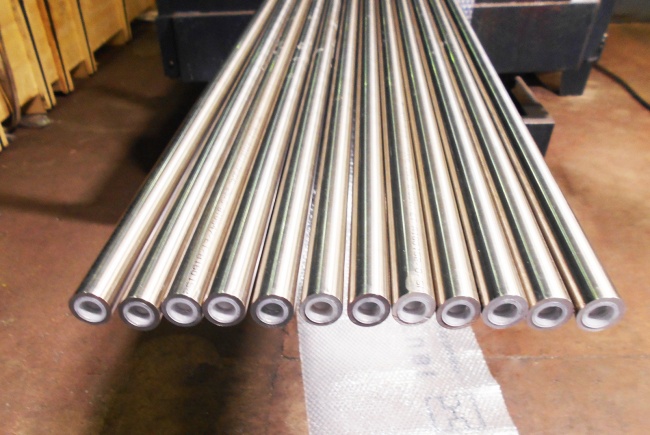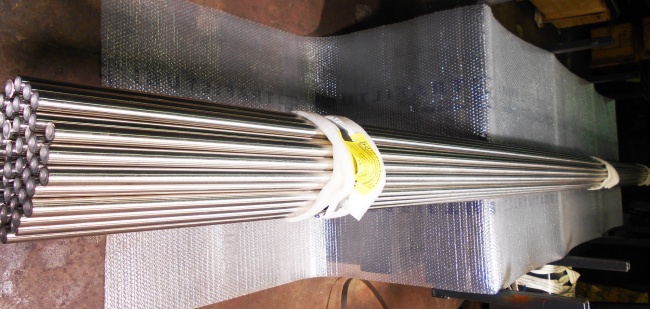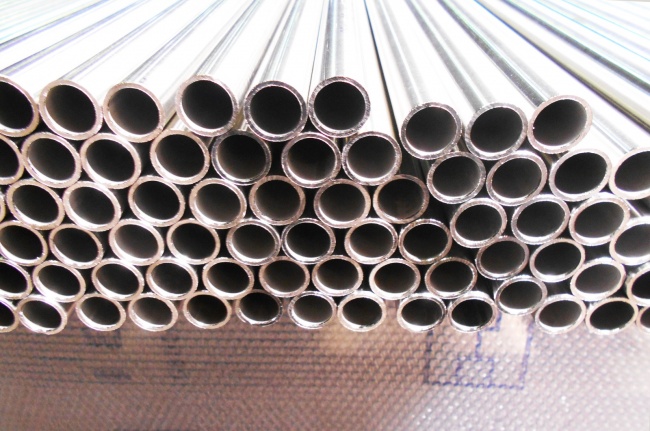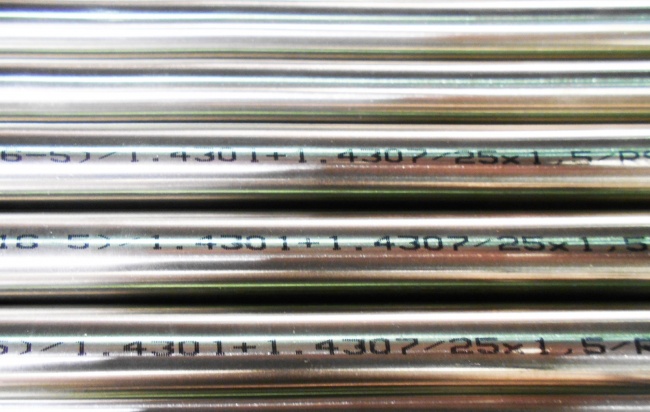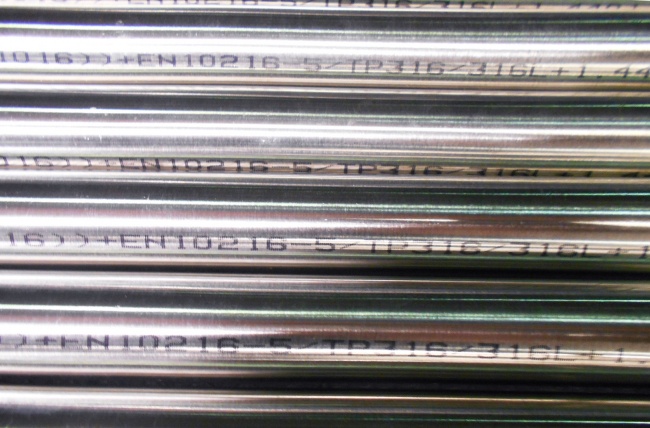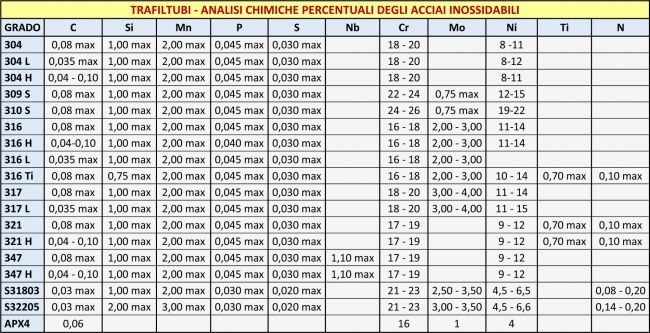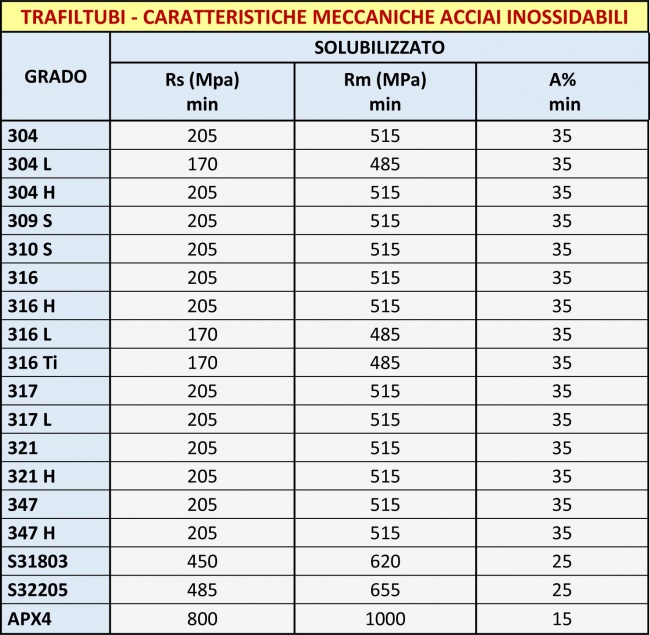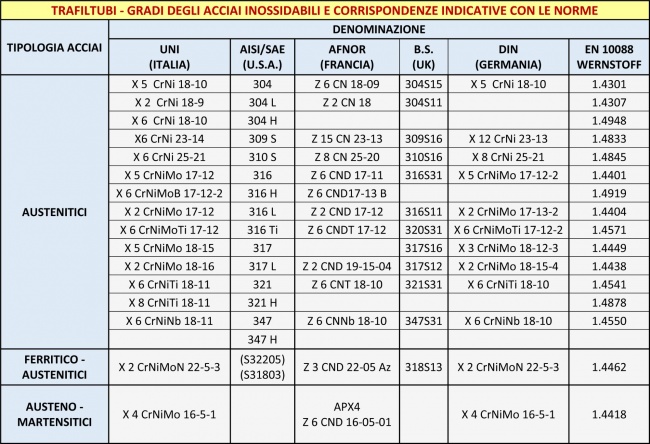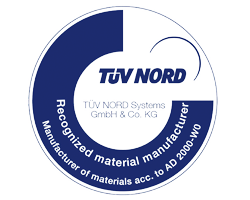Trafiltubi produces pipes in a variety of austenitic, ferritic, duplex and superduplex stainless steels as well as in some martensitic stainless steels. Among the latter the exclusive HinoxTube®, a martensitic steel that combines the best characteristics of martensitic and austenitic steels: it presents in fact high mechanical properties, good weldability and excellent resistance to corrosion. So it is suitable to the construction of high-resistance stainless structures. HinoxTube® is patented by Trafiltubi and results from the drawing of APX4, a material previously patented by the steel mill Aubert & Duval [download here the brochure special stainless APX4].
Trafiltubi supplies further qualities of steels, available on request, in addition to those indicated in the attached tables.
Austenitic stainless steels
1.4301 (AISI 304) - 1.4307 - 1.4305 (AISI 303) - 1.4306 (AISI 304L) - 1.4401 (AISI 316) - 1.4404 (AISI 316L) - 1.4435 - 1.4439 - 1.4571 (AISI 316Ti) - 1.4539 (AISI 904L) - 1.4541 (AISI 321) - 1.4462
They contain chromium (16 - 20%), nickel (7 - 18%) and some qualities also contain molybdenum (2 - 6%) while the content of carbon is usually below 0.08%. The presence of stabilizing elements, titanium for instance, improves their resistance to intergranular corrosion, conferring greater resistance to high temperatures too. They are characterised by good weldability, excellent resistance to corrosion, excellent hygienic coefficient, and are easy to work and clean. They cannot be magnetised when annealed. These steels, characterised by an austenitic structure that is stable at all temperatures, do not show any improvement in mechanical strength after heat treatment. Their mechanical resistance can be increased by adding nitrogen or by cold working (like cold drawing processes, indeed) because such workings, hardening the material, increase its hardness.
Duplex stainless steels
they are called duplex because of their mixed structure. At room temperature, they present a biphasic structure made of austenite and ferrite: hence their name biphasic or austeno-ferritic. They are stainless steels with a high content of chromium, always above 16%, a basic low content of nickel (5% - 6%), and combined with elements such as molybdenum, silicon, manganese and copper. Their weldability is slightly superior to that of austenitic and ferritic steels. At room temperature they present higher mechanical characteristics than those of austenitic and ferritic steels, their resistance to corrosion is better than ferritic, (in particular they are resistant to corrosion from pitting and under tension) and comparable, in acid environment, to austenitic. They can be easily welded and worked, have good tensile and yield strength; a high level of passivation (due to the high content of chromium and to the presence of molybdenum), therefore also a higher resistance to pitting corrosion than austenitic steels.
Ferritic stainless steels
heat- resistant 1.4713 - 1.4742 - 1.4762 - 1.4828 - 1.4841 - 1.4845 - 1.4923
These steels contain chromium (12 ÷ 27%) and carbon usually ≤ 0,20% with possible additions of other elements. Because of their ferritic structure at every temperature, it is not possible to improve their mechanical characteristics through heat treatments. Yield strength and hardness can be improved through cold working (like the cold drawing indeed) which results in hardening the material. They can be welded using all the various fusion and resistance methods. The coarse crystalline structure formed at welding temperature tends to cause both the filler metal and the base metal areas affected by heating to become brittle. The recrystallization treatment after welding is essential, even if it does not eliminate the drawback. Stainless ferritic steels present a good resistance to scaling up to 750-800°C. However, it is important taking into account that these steels are affected by embrittlement if heated even for short periods in the range 400-600°C, or for long periods in the range 600-800°C. This phenomenon occurs only when the material is cooled at room temperature and never occurs at high temperatures. These steels are characterised by a sharp drop in toughness at low temperatures and are therefore not suitable for use below room temperature.
Please refer to the complete brochure of technical tables, to choose among the wide range of types of steel the one that is most suitable to your applications: for more information see the stainless steels tecnichal data sheets.
